Notes: The station was located on the west side of a one way loop at the end of Banhofstraße about 400 yards north of the Leipziger Straße level crossing. The main line was single track either side of the station. Four lines ran though the station, two served platforms and that on the west side was a through line. There were two platforms, the main station building was a large rectangular two storey building with large central gables projecting onto the platform and onto the cobbled station forecourt. There were two single storey buildings either side of the main building both with a pitched roof. One butted on to the main building on the south side, that on the north side was end on to the platform. These extensions were built later and are not seen in the first photo below. There was a sloping canopy supported on five columns for weather protection in front of the entrance. There was a large cast iron name board on the front of the canopy and two smaller ones at either end. There was a smaller sign on a pole beyond the platform buildings to the north.
The second slightly shorter platform was an island with no buildings or signs. Only one (west) platform face of the island was ever used with the right side of the platform sloping down to ground level. Passengers reached the island platform using two boarded foot crossings either side of the canopy. Photographic evidence suggest that only the west face of the island platform was still in use b y 1998.
The goods yard was to the north of the station on the east side of the line; it comprised six sidings. It had a large two storey goods shed with a pitched roof and a canopy projecting both over the loading dock facing a siding and over the opposite side to protect road vehicles being loaded and unloaded. Two parallel sidings ran infront of the shed while another two sidings ran either side of a loading dock on the north side of the shed. A fifth, shorter siding ran along the southern perimeter of the yard. There was a second long building alongside the access road but this had gone by 2015. An additional loop siding on the west side of the main line served another loading dock. The yard closed with the line on 27 May 2000. The goods shed itself was demolished and most of the goods yard sidings lifted by 2018. Road access to the yard was from the end of Bahofstraße. There was an agricultural warehouse, built in 1930, on the east side of the line immediately north of the level crossing. This was served by a siding and dock on the west side and two road loading bays on the east side. This building has now been converted into flats.
Colditz was provided with two signal boxes designated W1 and B2. W1 was the crossing box opposite the warehouse which would also have also controlled the warehouse sidings. This box is complete with all its equipment but is derelict; it closed 6 December 1999. The B2 box was located opposite the entrance to the goods yard on the approach to the station from the north. The B2 was a 'Command' Box (Befehlsstellwerk 2), with the W1 box at the other end of the station site being a 'Dependent' box. In other words B2 was the main signal box. This box which closed with the line on 27 May 2000. is also extant and derelict.
BRIEF HISTORY OF THE GLAUCHAU TO WURZEN LINE
Already in 1860, a committee formed in Penig with the aim of constructing a railway from Glauchau to Wurzen. In 1864 the Saxon parliament permitted the construction of a railway from Leipzig along the Mulde valley to Chemnitz. Since no private entrepreneur could be found for this project, permission was granted instead in 1868 for a railway from Glauchau via Wurzen to the border with Prussia. The private Muldenthal-Eisenbahngesellschaft was awarded the concession for the construction and operation of a railway between Glauchau and Wurzen on 29 April 1872. No concession was granted for the line to the border, because a continuation in Prussia could not be guaranteed.
While the right of way was intended for double-track operation which was taken into account in the construction of the Rochsburg tunnel and several bridges, due to the lack of a northern continuation the traffic never reached the levels that would have justified doubling of the line. Nevertheless the line was built to mainline standards. It was put into operation in several stages:
- from Glauchau to Penig on 10 May 1875
- from Rochlitz to Großbothen on 9 December 1875
- from Penig to Rochlitz on 29 May 1876
- from Großbothen to Wurzen on 30 June 1877
On 1 August 1878 the Muldenthal-Eisenbahngesellschaft was taken over by the Saxon state, the line and the rolling stock passed into the hands of the Royal Saxon State Railways. The separate station in Wurzen was closed, and the station of the Leipzig–Dresden railway became the terminus of the Muldentalbahn.
The Rabenstein bridge near Grimma was strengthened in 1931 which was possible without interrupting the traffic, because the line and the bridge had been prepared for double-tracked operation.
On 15 April 1945 the Rabenstein bridge across the Mulde river was destroyed, and the line remained interrupted between Großbothen and Grimma unterer Bahnhof. Tracks on this section were lifted for war reparations, and despite repairs to the bridge they were never relaid. Passenger traffic between Grimma unterer Bahnhof and Nerchau ceased on 28 May 1967, but was partly reopened with trains between Golzern and Wurzen on 24 September 1967, before ceasing on this section completely on 31 May 1969. The Wurzen-Golzern section remained in operation for freight traffic as an extended siding of Wurzen station, and tracks were renewed between Nerchau and Golzern in the 1970s. The right of way near Dorna-Döben station was used for a widening of the parallel road.
A connecting curve between this line and the Borsdorf–Coswig railway was built south of Großbothen in the mid-1970s. It was mainly intended for strategic reasons and was only used for regular traffic for a short time in 1995 while a bridge in Großbothen was renewed. Preparations had been made for deploying a temporary bridge across the River Mulde between Neichen and Trebsen, the terminus of the line from Beucha. For this purpose, a track had been laid from Trebsen station to the left bank of the river.
Freight traffic between Wurzen and Golzern ended on 2 June 1996. Only a short section between Wurzen and a silicate factory in nearby Dehnitz remains in operation, the remainder of the Wurzen–Grimma section has been transformed into a cycle trail.
Faulty trackwork caused the passenger trains between Colditz and Rochlitz to be replaced by buses from 6 December 1999, and freight traffic between Großbothen and Wechselburg officially ceased on 5 December 1999. Passenger traffic between Rochlitz and Großbothen ceased on 27 May 2000, freight traffic between Glauchau and Wechselburg on 2 July 2000, and passenger traffic between Wechselburg and Rochlitz on 9 June 2001. Operations on the last section between Glauchau and Wechselburg ceased on 13 August 2002 in the course of the 2002 European floods which caused widespread damage in the area, and because of the poor state of the line and several engineering works along it. Colditz acted as a terminus between 6 December 1996 and 27 May 2000 following closure of the line to Rochlitz because of faulty trackwork.
Deutsche Regionaleisenbahn (DRE) leased the Glauchau-Großbothen line and the Rochlitz–Narsdorf section of the Rochlitz–Penig railway in 2005 with the intention of preserving the infrastructure and resuming the traffic in stages. Lack of finances, damages to the embankment following the construction of a motorway, and damages to bridges due to vehicle collisions have delayed the resumption of operations, so that the first DRE train between Glauchau and Wolkenburg could only run in October 2010. After some sections of track had been cleared of vegetation, a regional support association in cooperation with a major Saxon railway club have conducted several touristic operations with a track motor car.
When the grounds and the infrastructure of the line were sold by Deutsche Bahn to a private company in Chemnitz in late 2015, fears of a dismantlement of the line were countered by a successful petition for the line being granted the status of a protected monument. This was awarded in early 2016
In October 2021 the Leipziger Volkszeitung newspaper reported a scheme to reoopen the line between Colditz and Rochlitz. Despite photos of local politicians including the mayor of Colditz Robert Zillmann, standing on the disused track at Rochlitz nothing ever came of the scheme.
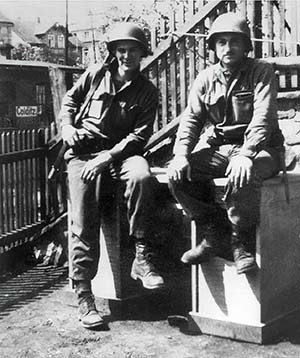 The town of Cilditz is inextricably linked with Colditz Castle. The town of Cilditz is inextricably linked with Colditz Castle.
The station was used during WW2 for peisoner transfer amongst other things. The castle dates back to 1083 but, following a fire, it was reconstructed in 1503. During the early 19th century it became a workhouse to feed the poor, ill and criminals becoming a mental hospital and sanatorium in 1829.
When the Nazis gained power during 1933, they converted the castle into a political prison with allied prisoners being housed there from 1939 when it was converted into a high security prisoner-of-war camp for officers who had become security or escape risks or who were regarded as particularly dangerous. After liberation on 16 April 1945 the station was in regular use and this photo shows US Staff Sergeant Sarube (right) in Colditz station yard in April 1945.
When Colditz Castle became a tourist attraction, the station had already closed. If it was still open it would have been ideally sited for visitors. Visitors uising public transport should catch a regional train from Leipzig to Großbothen (every hour on weekdays and 2 hours at weekends). From Großbothen bus 619 takes 1 hour 18 minutes to reach Colditz. Click here for a brief history of Colditz Castle
Sources (apart from Wikipedia, all web sites are in German):
|

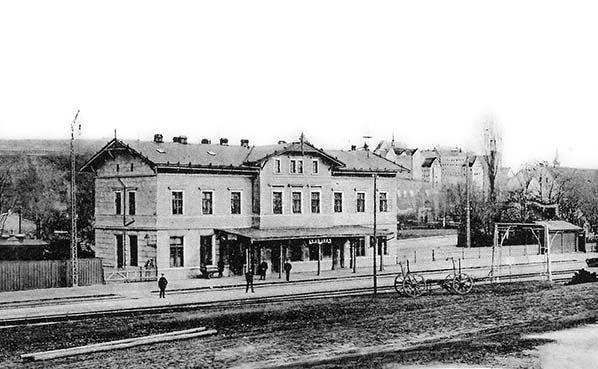


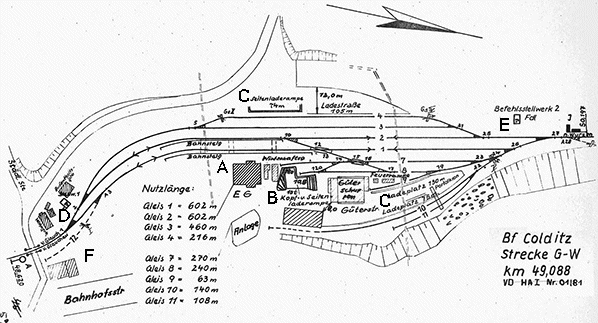 Colditz station and goods yuard track plan. A - Station, B - Goods Shed, C - Loading Dock, D - W1 Signal Box, E - B1 Signal Box, F - Rail served warehouse.
Colditz station and goods yuard track plan. A - Station, B - Goods Shed, C - Loading Dock, D - W1 Signal Box, E - B1 Signal Box, F - Rail served warehouse.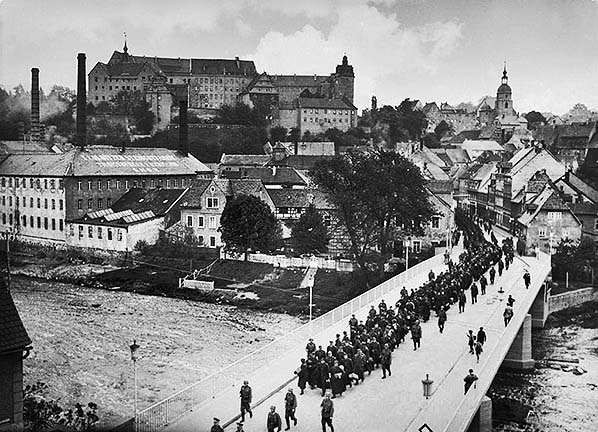
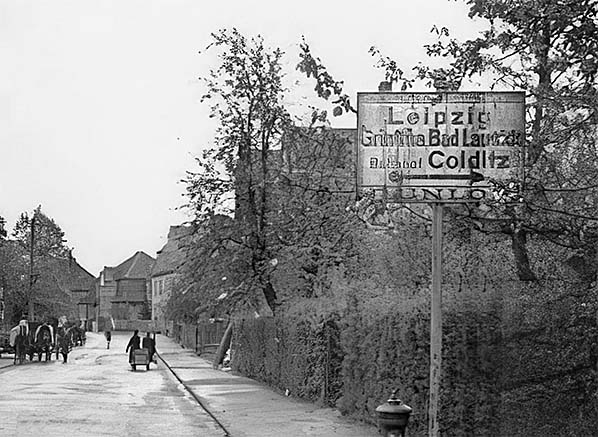
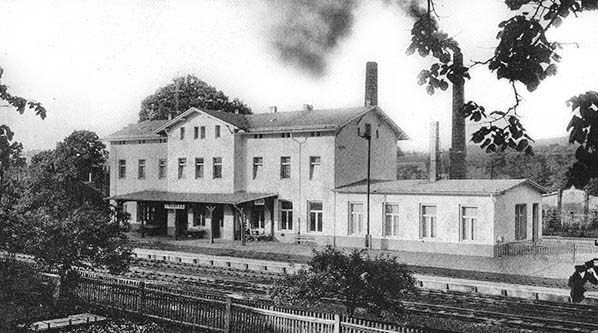
old16.jpg)
old12.jpg)
 The town of Cilditz is inextricably linked with Colditz Castle.
The town of Cilditz is inextricably linked with Colditz Castle.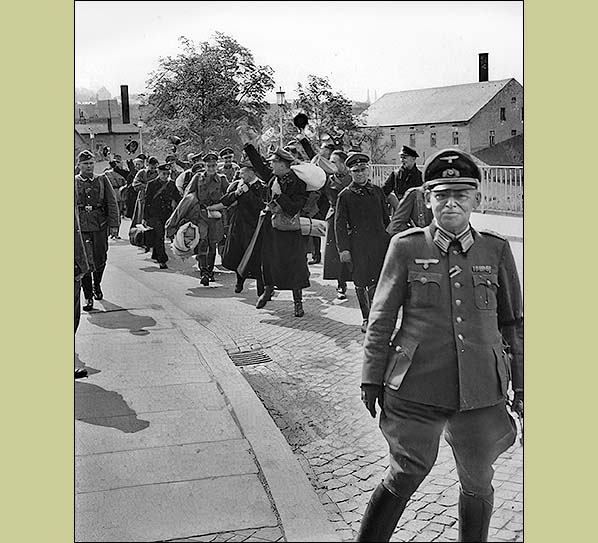
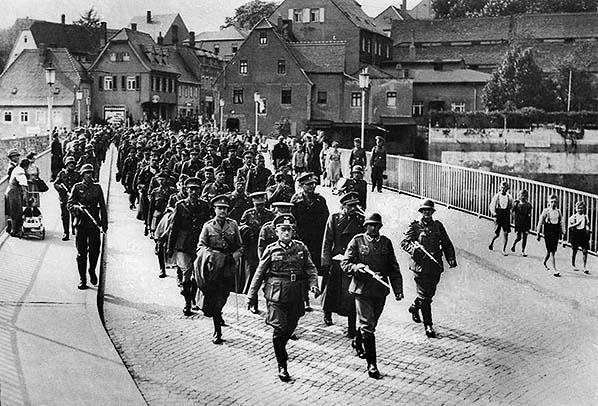

 Home Page
Home Page